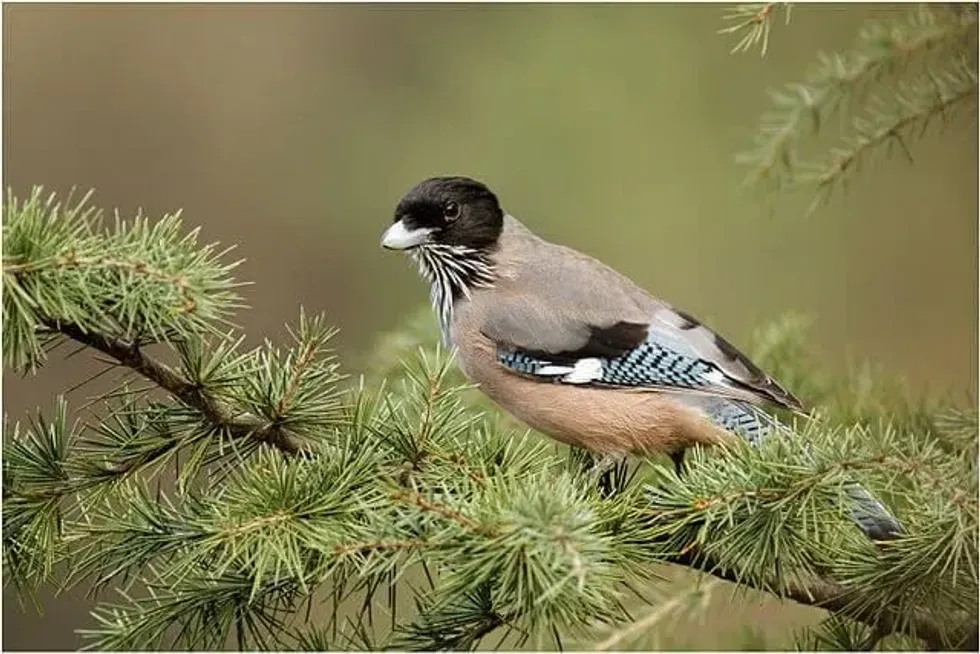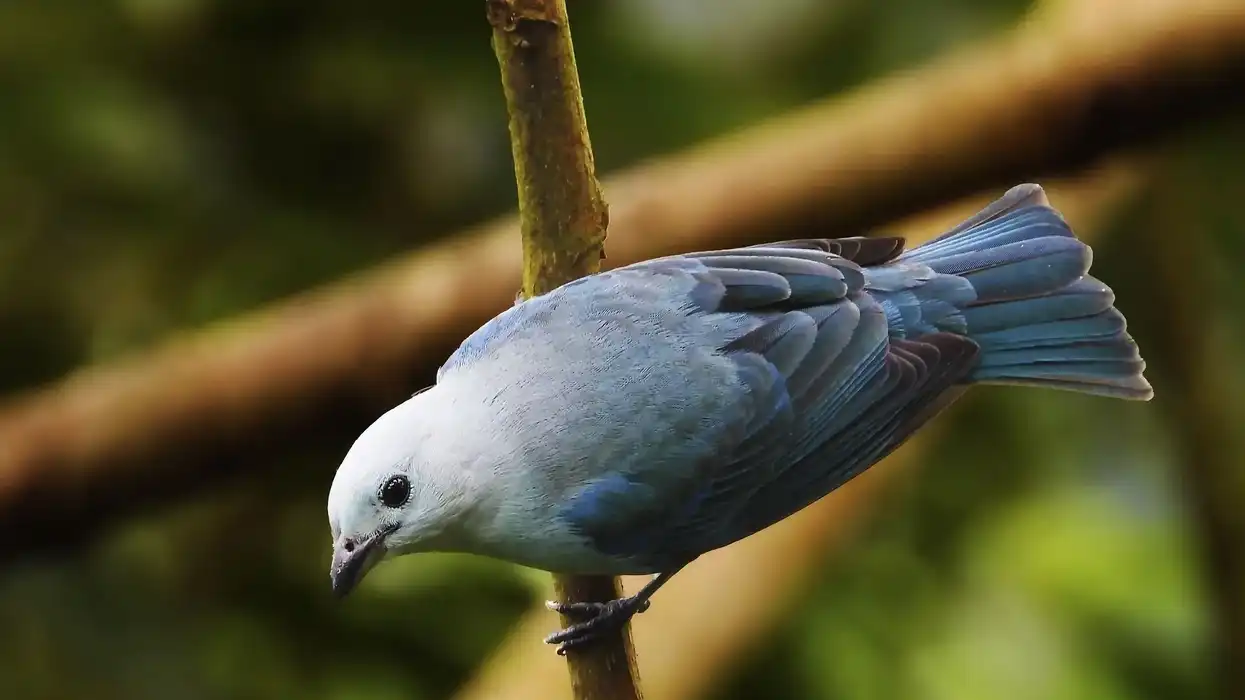The black-headed jay (Garrulus lanceolatus) is a bird that belongs to the genus Garrulus and order Passeriformes is known as 'geai lancéolé' in French. It is a common bird and a resident of a wide range, distributed across India, Nepal, Afghanistan, and Pakistan.
The hills located at an altitude of 4900 and 9800 ft (1500-3000 m) of central and western Himalayas are home to these birds.
It thrives in a vast, open forested habitat as well as tropical and sub-tropical forests, shrublands, pine-oak woods, and also in agricultural areas with plenty of trees.
The greyish-pink plumage of this medium-sized jay is highlighted by a black head and a scruffy crest. This bird's throat is black with prominent white stripes.
During the breeding season, their diet comprises invertebrates, tiny vertebrates but during the non-breeding season, their diet includes seeds and berries. They occasionally search for abandoned food scraps from nearby villages to feed on.
According to the International Union for Conservation of Nature (IUCN) Red List, the conservation status of these birds are of Least Concern.
For more relatable content, check out these blue jay facts and ovenbird facts for kids.
Black-Headed Jay Interesting Facts
What type of animal is a black-headed jay?
Black-headed Jay (Garrulus lanceolatus) is a bird that belongs to the family of crows, also known as Corvidae. These birds are closely related to the Lidth's jay (Garrulus lidthi) and the Eurasian jay (Garrulus glandarius).
What class of animal does a black-headed jay belong to?
Black-headed jay (Garrulus lanceolatus) is a member of the Aves class and Garrulus genus of Animalia Kingdom. This bird is also known as lanceolated jay.
How many black-headed jays are there in the world?
The world population of these species has not been quantified. However, it is known that their population is stable and widespread throughout their range.
Where does a black-headed jay live?
The black-headed jay (Garrulus lanceolatus) has a wide range, distributed across India, Nepal, Afghanistan, and Pakistan. In India, the states of Jammu and Kashmir, Uttarakhand, Himachal Pradesh, Uttar Pradesh and Punjab are home to these birds. They are also found in eastern Afghanistan, the western Himalayas, and areas of North Pakistan and East Nepal.
What is a black-headed jay's habitat?
Black-headed jay (Garrulus lanceolatus) thrives in a large, open forested area instead of a dense forest. These species are found in tropical and sub-tropical forests, forest edges, pine-oak forests, especially in the foothills of the Himalayas at an elevation of 4900- 9800 ft (1500-3000 m).
Apart from that, they can also be spotted in agricultural farms with abundant trees and scrublands.
Who do black-headed jays live with?
The black-headed jay (Garrulus lanceolatus) is a gregarious bird that is usually observed in pairs or small groups. During the winter, they can be found in flocks of 30-40 birds of other bird species.
How long does a black-headed jay live?
The lifespan of these species is unknown due to a lack of data. However, other birds of the Corvidae family throughout the world live for approximately 7-15 years in the wild.
How do they reproduce?
April to June is the breeding season of these monogamous species. The breeding occurs in a solitary area, after which both of them build their nests loosely with the help of twigs, rootlets, and grass at a height of 16-23 ft (5-7 m).
These nests are constructed on top of small oak trees or bushes. Afterward, the female lays 4-6 white eggs in this nest and solely incubates them for 14-16 days.
During the incubation period, the males take the responsibility to provide food for females. After the eggs hatch, both the parents look after the nestlings who become independent after 21-23 days.
These birds are fiercely protective of their nests as well as the young ones and will attack if they feel threatened. The mating habit of this species is very similar to their related species, the Eurasian Jay.
What is their conservation status?
According to the International Union for Conservation of Nature (IUCN) Red List, the black-headed jay (French name- geai lancéolé) species are of Least Concern. This is because their population is quite thriving in their range and therefore does not need any immediate conservation measures.
However, habitat loss, illegal hunting for trade are a few threats that these species might face in the future.
The conversation status of these birds according to the CITES (Convention on International Trade in Endangered Species of Wild Fauna and Flora) is Not Evaluated.
Black-Headed Jay Fun Facts
What do black-headed jays look like?
This medium-sized jay, Garrulus lanceolatus, has a greyish-pink plumage along with a black head and a shabby crest. The throat of this bird is black with heavy white streaks.
Moreover, their wings and long tail are blue in color with thick dark gray, white, and black bars. Its bill is short and thick with a silvery-white color while its feet and legs are bluish-gray.
They have dark brown eyes. Their approximate length is 12-13 in (30-33 cm). A juvenile has a dull brown plumage and a short crest.
How cute are they?
Like brewer's blackbird, adult black-headed jays (French name- geai lancéolé) are adorable to watch when the male feeds the female in the nest while she is incubating the eggs. Juveniles, on the other hand, are dull and dark brown and do not appear to be cute. These species also make really unpleasant sounds.
How do they communicate?
Black-headed jay (Garrulus lanceolatus) communicates by making piercing high-pitched 'skaaak' sounds. They often try to mimic other animals' noises in captivity.
Apart from auditory communication, these birds also communicate visually. They have various displays and postures where they fluff out their plumage while keeping their bill pointed upwards. During the breeding season, males move around females as a part of their mating rituals.
How big is a black-headed jay?
Black-headed jays are 12-13 in (30-33 cm) in length, which is longer than an average mockingbird.
How fast can a black-headed jay fly?
The exact speed of this bird is not yet determined. However, it is noticed that the black-headed jay flying is usually quite laborious where the bird has to repeatedly beat their relatively short wings.
How much does a black-headed jay weigh?
The average weight of a black-headed jay (French name- geai lancéolé) is 3-3.5 oz (80-100 gm). These dark crested birds are considered to be pretty light.
What are the male and female names of the species?
Male and female black-headed jays are referred to as 'cocks' and 'hens' respectively.
What would you call a baby black-headed jay?
A baby black-headed jay (Garrulus lanceolatus) is known as a nestling or a chick.
What do they eat?
During the breeding season, the diet of these omnivores comprises invertebrates, tiny vertebrates such as small birds, lizards, small eggs, and hatchlings of other birds, which they eat both on the ground and in trees. During the fall and winter months or non-breeding seasons, this bird also feeds on seeds and berries.
These species occasionally transform into scavengers, and therefore search and pick abandoned food scraps from nearby villages and human habitation. Acorns are their favorite, which they save to feed themselves later.
Are they poisonous?
No, these birds are not poisonous. Although they pose no threat to humans, they are fiercely territorial. As a result, if they believe their young ones are in danger from a predator, they may become aggressive. They will raise their crest, flick their wings and tails while making excruciatingly loud sounds.
Would they make a good pet?
No, lanceolated jay is a wild bird, and therefore it is not recommended to domesticate it.
Did you know...
The genus Garrulus derives its name from the Latin word Garrulus, meaning 'noisy' which describes these babbling birds perfectly.
During the winter season, these resident birds may migrate to lower elevations from higher elevations.
What is unique about the black-headed jay?
The greyish-pink plumage as well as a black hood and a scruffy crest, are used as an identification of a black-headed jay. It has a black throat with plenty of white stripes.
Furthermore, the long tail and wings are blue in color with thick dark gray, white, and black bars. It has a small, broad bill that is silvery-white in color, and its feet and legs are bluish-gray. This bird is almost identical in size to the Eurasian Jay, but is smaller and has a shorter and thicker bill.
How many types of jay are there?
Jays belong to the family Corvidae and the order Passeriformes, and there are about 35-40 different species in the world. The hostility of these birds is a typical feature. Their color and abilities change depending on their habitat. Some of the species are blue jay, Eurasian jay, steller's jay, California scrub jay, florida scrub jay, and Mexican jay.
Here at Kidadl, we have carefully created lots of interesting family-friendly animal facts for everyone to discover! For more relatable content, check out these swallow facts and eastern meadowlark facts pages.
You can even occupy yourself at home by coloring in one of our free printable black headed jay coloring pages.









